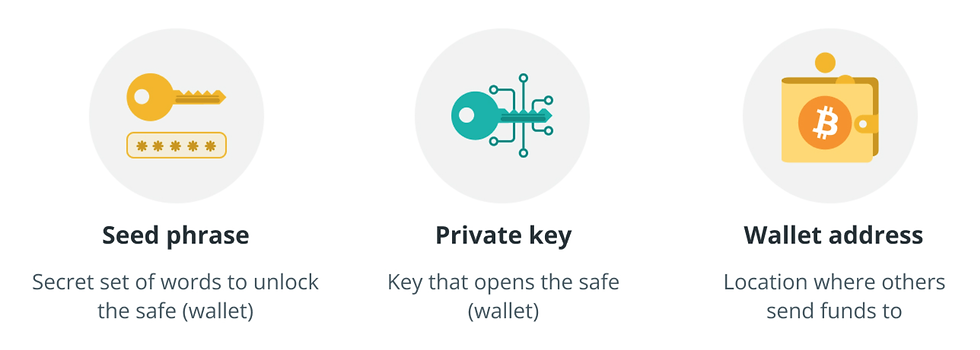Why Are Seed Phrases Important?
- Slava Jefremov
- Jul 18
- 7 min read

Introduction
Welcome to the world of cryptocurrency, where you are your own bank. This newfound financial sovereignty comes with great power and even greater responsibility. At the heart of this responsibility lies a simple yet critical concept: the seed phrase. If your crypto wallet is a digital vault, the seed phrase is the unchangeable, irreplaceable master key. Losing it can mean losing everything, with no one to call for help.
This guide will demystify the seed phrase. We will explore what it is, how it works, its critical role in the crypto ecosystem, and, most importantly, the best practices for keeping it secure. Understanding and respecting the power of your seed phrase is the single most important step you can take to protect your digital assets.
Key Takeaways
A seed phrase is a list of 12 to 24 words that acts as the master key to all the funds in your cryptocurrency wallet.
Its main function is to restore your wallet and access your funds if you lose your device, forget your password, or need to switch to a new wallet application.
If you lose your seed phrase for a non-custodial wallet, your funds are permanently and irretrievably lost. There is no "forgot password" option.
Never share your seed phrase with anyone, ever. Anyone who has your seed phrase has total control over your crypto. Legitimate support staff will never ask for it.
The most secure way to store your seed phrase is offline, written on a durable material like paper or steel, and kept in a safe, private location.
What is a Seed Phrase and Why is it So Important?
A seed phrase (also known as a recovery phrase), mnemonic phrase, or backup seed—is a sequence of 12 to 24 simple words generated by your cryptocurrency wallet when you first create it. These words are not random prose; they are a human-readable representation of a long, complex random number that is used to derive all your private keys.
The importance of a seed phrase cannot be overstated. It is the ultimate backup for your entire wallet. If your phone breaks, your computer crashes, or you forget your wallet's password, you can simply download a compatible wallet application on a new device and enter your seed phrase to restore full access to your cryptocurrency. Without it, regaining access is nearly impossible, and your funds could be lost forever.

Consider the cautionary tale of James Howells, who in 2013 accidentally threw away a hard drive containing the private keys to 8,000 Bitcoin. As of late 2024, that stash would be worth hundreds of millions of dollars. Because he has no seed phrase to restore his wallet, his digital fortune is buried under a mountain of rubbish in a landfill, likely lost forever. This story is a stark reminder of why securing your seed phrase is paramount.
A Brief History of Seed Phrases
Before 2012, managing crypto wallets was cumbersome, often requiring users to back up individual private keys. The introduction of Hierarchical Deterministic (HD) wallets through a proposal called BIP-32, followed by the mnemonic standard BIP-39 in 2013, revolutionized wallet security and user experience. This new standard introduced the concept of using a single master seed phrase to generate a near-infinite tree of private keys and public addresses, making backups simple, secure, and standardized.
How Do Seed Phrases Work?
When you set up a new non-custodial wallet, it uses the BIP-39 standard to generate your seed phrase. The process starts with creating a large random number (entropy). This number is then converted into a mnemonic sequence by mapping it to a specific, curated wordlist containing 2048 carefully chosen words. The result is a unique phrase of 12 to 24 words.
For example, a 12-word seed phrase might look like this:
glory approve auto magic sibling absorb trick protect vast search solve away
The beauty of this system is that it is deterministic. This means that the exact same seed phrase will always generate the exact same set of private keys and public addresses in the exact same order, regardless of which compatible wallet software you use. It’s like a universal blueprint for your funds that you can carry in your head or on a piece of paper.

Seed Phrases, Private Keys, and Wallet Addresses: What's the Connection?
To understand how your wallet functions, think of it as a digital safe deposit box system.
Wallet Address: This is like your public bank account number. You can share it freely with anyone who wants to send you cryptocurrency. It is derived from your public key, which in turn is derived from your private key.
Private Key: This is the actual key that unlocks a specific safe deposit box (a specific part of your wallet) and authorizes transactions. You should never share your private keys. A wallet typically manages many private keys.
Seed Phrase: This is the master key that can regenerate all of your private keys. If you lose your entire keychain (all your private keys), the seed phrase allows you to create a brand new, identical one from scratch.

In short: Seed Phrase → Master Private Key → Multiple Individual Private Keys → Public Keys → Wallet Addresses.
Can a Seed Phrase Be Hacked?
Technically, a seed phrase is too complex to be "hacked" by brute force. A 12-word seed phrase has 204812 possible combinations, a number so astronomically large that it is computationally impossible to guess.
However, a seed phrase can be stolen. If a malicious actor gets a copy of your seed phrase, they can import it into their own wallet and drain your funds. Here are the most common ways a seed phrase is compromised:
Phishing Attacks: Scammers create fake websites or apps that mimic legitimate wallet services, tricking you into entering your seed phrase to "verify your wallet" or "claim an airdrop."
Insecure Storage: Storing your seed phrase in a digital format—such as in a text file on your computer, a cloud drive (Google Drive, Dropbox), an email, or as a photo on your phone—makes it highly vulnerable to hackers.
Malware and Spyware: Keyloggers or other malicious software on your device can record your keystrokes as you type your seed phrase or scan your files for it.
Social Engineering: An attacker might pose as a customer support agent and manipulate you into revealing your seed phrase under the pretext of helping you with a technical issue.
What Happens If You Lose Your Seed Phrase?
The consequences of losing your seed phrase depend entirely on the type of wallet you use.
Non-Custodial Wallets (e.g., MetaMask, Ledger, Trezor): In these wallets, you are in complete control. The provider does not store your keys or your seed phrase. If you lose your seed phrase and have no backup, there is absolutely no way to recover your wallet. Your funds are gone forever. This is the harsh reality of "not your keys, not your crypto."
Custodial Wallets (e.g., accounts on Coinbase, Binance): With these services, the exchange holds your private keys for you. You don't have a seed phrase for your exchange account itself. If you lose your password, you can recover your account through traditional methods like email or ID verification. However, you are trusting the exchange with your funds, which introduces counterparty risk.
Third-Party Recovery Services: Some services claim to help with wallet recovery. Be extremely cautious. While some may be able to help if you have a partially correct seed phrase or a corrupted backup, many are scams designed to steal what funds remain. Always research these services thoroughly.
How to Safely Store and Back Up Your Seed Phrase
Properly storing your seed phrase is the most critical security measure you can take. Your goal is to protect it from theft, loss, and damage.
Go Offline Immediately: Never store your seed phrase on any device connected to the internet. Write it down on paper or, for better durability, etch it onto a steel plate designed for crypto backups. This protects it from all online threats.
Store in Multiple, Secure Locations: Don't put all your eggs in one basket. Consider splitting your backup into two or three parts and storing them in geographically separate, secure locations. This could include a fireproof safe at home, a bank's safe deposit box, or with a trusted family member.
Use Multisignature (Multisig) Wallets: For high-value holdings, a multisig wallet adds an exceptional layer of security. It requires two or more private keys (and thus multiple seed phrases) to authorize a transaction, making it impossible for a thief to steal funds with just one compromised phrase.
Test Your Backup: After creating your backup, perform a dry run. Wipe your wallet (after ensuring funds are minimal or zero) and try to restore it using your written-down seed phrase. This confirms that you wrote it down correctly and that the backup is readable and works.
Never Speak or Type it Digitally: Avoid reading your seed phrase aloud where it could be recorded. Do not type it into any website, app, or digital document unless you are 100% certain you are performing a legitimate wallet recovery. Remember: customer service will NEVER ask for it.
Conclusion
The seed phrase is more than just a random collection of words; it is the bedrock of self-custody in the cryptocurrency world. It represents true ownership and control over your digital assets. While this power is liberating, it demands a disciplined and proactive approach to security. By understanding what your seed phrase is, how it works, and the best practices for storing it, you can protect yourself from catastrophic loss. Treat your seed phrase with the same care and secrecy as you would the keys to a vault filled with your most valuable possessions.
Frequently Asked Questions
Does the order of the words in a seed phrase matter?
Yes, absolutely. The order is critical. The same 12 or 24 words in a different sequence will generate a completely different, and likely empty, wallet. You must record and enter the words in the exact order they were given.
Can I create my own seed phrase?
No. You should never create your own phrase. The words must be generated by a cryptographically secure random process from the official BIP-39 wordlist. Trying to create your own "memorable" phrase dramatically reduces its randomness and makes it vulnerable to being guessed.
What is the difference between a seed phrase and a private key?
A seed phrase is the master backup that is used to generate all the private keys within your wallet. A single private key typically controls the funds at a single address. The seed phrase is the root from which all keys grow.
Is it safe to take a picture of my seed phrase or store it in a password manager?
Absolutely not. A photo stored on your phone or computer is an online digital file, vulnerable to being stolen by hackers through malware or a cloud breach. Similarly, while password managers are great for passwords, storing your seed phrase in one creates a central point of failure. The best practice is to keep it fully offline.
How does a hardware wallet help protect my seed phrase?
A hardware wallet (like a Ledger or Trezor) is a physical device that generates and stores your private keys and seed phrase offline. When you want to make a transaction, you sign it on the device itself, so the seed phrase never touches your internet-connected computer. This provides an excellent defense against online threats like malware and phishing. However, you still need to back up the seed phrase (which the device shows you during setup) on paper or steel.



Comments